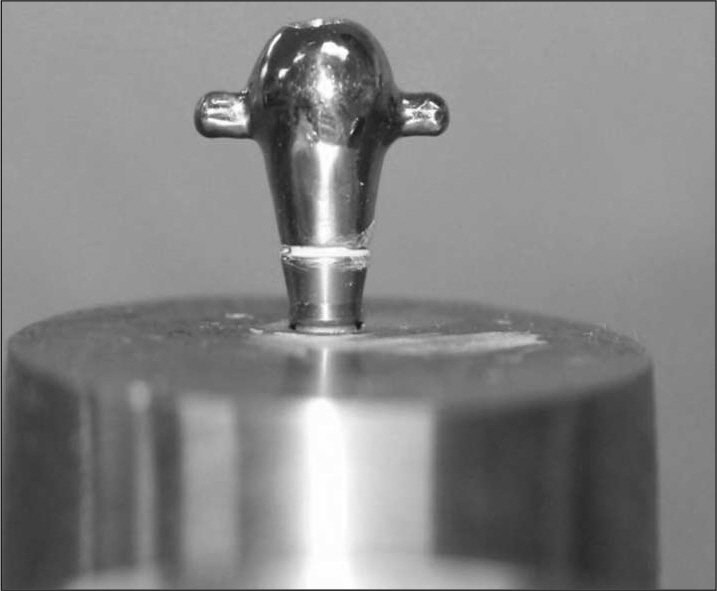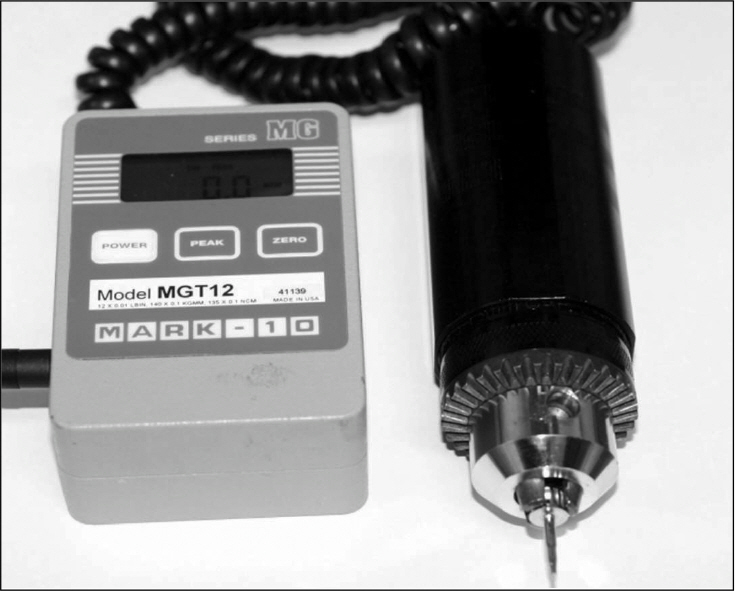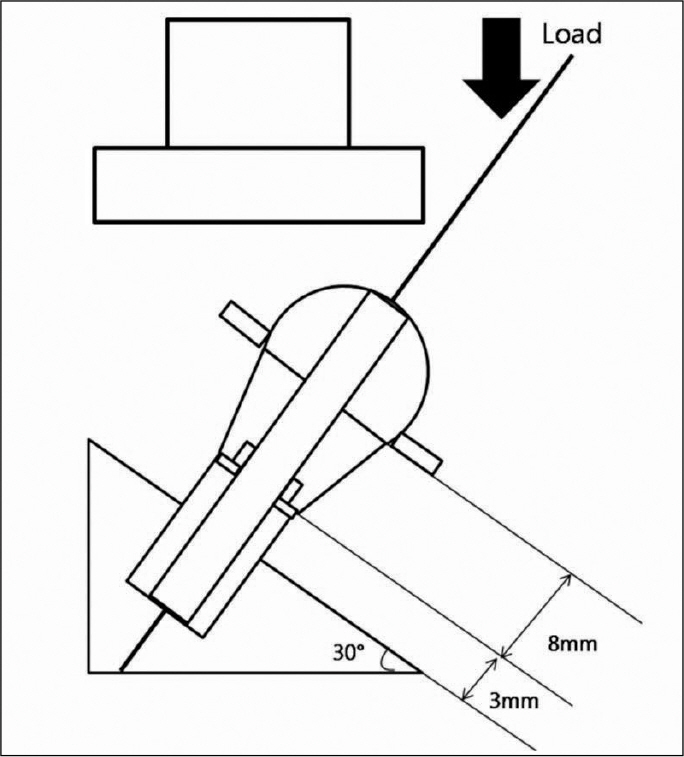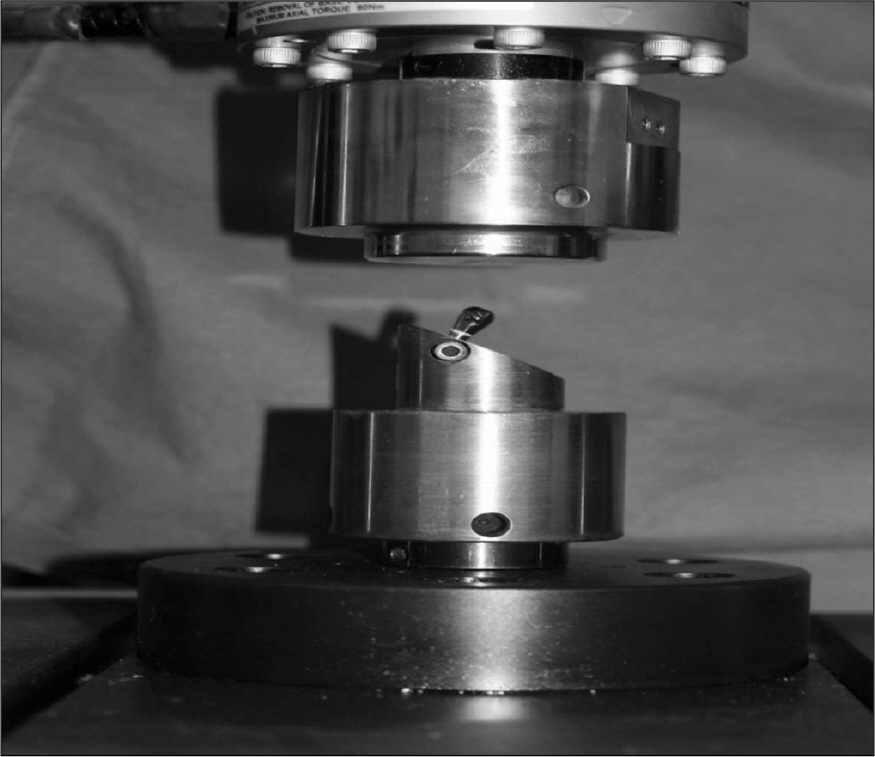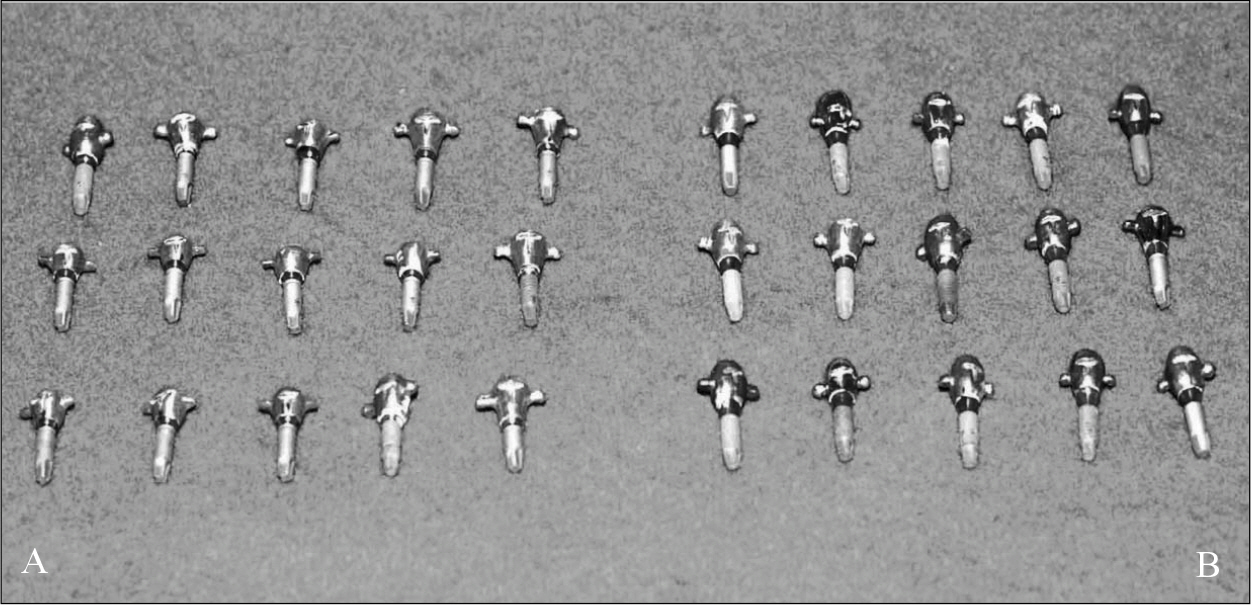J Korean Acad Prosthodont.
2008 Dec;46(6):561-568.
The assessment of abutment screw stability between the external and internal hexagonal joint under cyclic loading
- Affiliations
-
- 1Department of Prosthodontics, Graduate School, Seoul National University, Korea. proshan@unitel.co.kr
Abstract
-
STATEMENT OF PROBLEM: Currently, many implant systems are developed and divided into two types according to their joint connection: external or internal connection. Regardless of the connection type, screw loosening is the biggest problem in implant-supported restoration.
PURPOSE: The purpose of this study is to assess the difference in stability of abutment screws between the external and internal hexagonal connection types under cyclic loading.
MATERIAL AND METHODS: Each of the 15 samples of external implants and internal abutments were tightened to 30 N/cm with a digital torque gauge, and cemented with a hemispherical metal cap. Each unit was then mounted in a 30degrees. inclined jig. Then each group was divided into 2 sub-groups based on different periods of cyclic loading with the loading machine (30 N/ cm - 300 N/cm,14 Hz: first group 1 x 10(6), 5 x 10(6) cyclic loading; second group 3 x 10(6), 3 x 10(6) for a total cyclic loading of 6 x 10(6) The removal torque value of the screw before and after cyclic loading was checked. SPSS statistical software for Windows was used for statistical analysis. Group means were calculated and compared by ANOVA, independent t-test, and paired t-test with alpha = 0.05.
RESULTS
In the external hexagonal connection, the difference between the removal torque value of the abutment screw before loading, the value after 1 x 10(6) cyclic loading, and the value after 1 x 10(6), and additional 5 x 10(6) cyclic loading was not significant. The difference between the removal torque value after 3 x 10(6) cyclic loading and after 3 x 10(6), and additional 3 x 10(6) cyclic loading was not significant. In the internal hexagonal connection, the difference between the removal torque value before loading and the value after 1 x 10(6) cyclic loading was not significant, but the value after 1 x 10(6), and additional 5 x 10(6) cyclic loading was reduced and the difference was significant (P < .05). In addition, in the internal hexagonal connection, the difference between the removal torque value after 3 x 10(6) cyclic loading and the value after 3 x 10(6), and additional 3 x 10(6) cyclic loading was not significant.
CONCLUSION
The external hexagonalconnection was more stable than the internal hexagonal connection after 1 x 10(6), and additional 5 x 10(6) cyclic loading (t = 10.834, P < .001). There was no significant difference between the two systems after 3 x 10(6), and additional 3 x 10(6) cycles.
Keyword
Figure
Reference
-
1.Bra ° nemark PI., Hansson BO., Adell R., Breine U., Lindstro ¨ m J., Halle ´ n O., Ohman A. Osseointegrated implants in the treatment of the edentulous jaw. Experience from a 10-year period. Scand J Plast Reconstr Surg Suppl. 1977. 16:1–132.2.Adell R., Lekholm U., Rockler B., Bra ° nemark PI. A 15-year study of osseointegrated implants in the treatment of the edentulous jaw. Int J Oral Surg. 1981. 10:387–416.
Article3.Jemt T., Lekholm U. Oral implant treatment in posterior partially edentulous jaws: a 5-year follow-up report. Int J Oral Maxillofac Implants. 1993. 8:635–40.4.Nevins M., Langer B. The successful application of osseointegrated implants to the posterior jaw: a long-term retrospective study. Int J Oral Maxillofac Implants. 1993. 8:428–32.5.Sones AD. Complications with osseointegrated implants. J Prosthet Dent. 1989. 62:581–5.
Article6.Zarb GA., Schmitt A. The longitudinal clinical effectiveness of osseointegrated dental implants: the Toronto study. Part III: Problems and complications encountered. J Prosthet Dent. 1990. 64:185–94.
Article7.Jemt T., Linde ´ n B., Lekholm U. Failures and complications in 127 consecutively placed fixed partial prostheses supported by Bra ° nemark implants: from prosthetic treatment to first annual checkup. Int J Oral Maxillofac Implants. 1992. 7:40–4.8.Maeda Y., Satoh T., Sogo M. In vitro differences of stress concentrations for internal and external hex implant-abutment connections: a short communication. J Oral Rehabil. 2006. 33:75–8.
Article9.Jo ¨ rne ´ us L., Jemt T., Carlsson L. Loads and designs of screw joints for single crowns supported by osseointegrated implants. Int J Oral Maxillofac Implants. 1992. 7:353–9.10.Binon PP. The effect of implant/abutment hexagonal misfit on screw joint stability. Int J Prosthodont. 1996. 9:149–60.11.Worthington P., Bolender CL., Taylor TD. The Swedish system of osseointegrated implants: problems and complications encountered during a 4-year trial period. Int J Oral Maxillofac Implants. 1987. 2:77–84.12.Zarb GA., Schmitt A. The longitudinal clinical effectiveness of osseointegrated dental implants: the Toronto study. Part III: Problems and complications encountered. J Prosthet Dent. 1990. 64:185–94.
Article13.Hemmings KW., Schmitt A., Zarb GA. Complications and maintenance requirements for fixed prostheses and over-dentures in the edentulous mandible: a 5-year report. Int J Oral Maxillofac Implants. 1994. 9:191–6.14.Kallus T., Bessing C. Loose gold screws frequently occur in full-arch fixed prostheses supported by osseointegrated implants after 5 years. Int J Oral Maxillofac Implants. 1994. 9:169–78.15.Jemt T. Fixed implant-supported prostheses in the edentulous maxilla. A five year follow-up report. Clin Oral Implants Res. 1994. 5:142–7.16.Schwartz-Arad D., Samet N., Samet N. Single tooth replacement of missing molars: a retrospective study of 78 implants. J Periodontol. 1999. 70:449–54.
Article17.Binon PP. The external hexagonal interface and screw-joint stability: a primer on threaded fasteners. Quintessence Dent Technol. 2000. 23:91–105.18.Haack JE., Sakaguchi RL., Sun T., Coffey JP. Elongation and preload stress in dental implant abutment screws. Int J Oral Maxillofac Implants. 1995. 10:529–36.19.ISO/DIS 14801: Dental implants-Dynamic continuous fatigue test. 2003.20.Haack JE., Sakaguchi RL., Sun T., Coffey JP. Determination of preload stress in dental implant screws. J Dent Res. 1994. 73:202.21.Yousef H., Luke A., Ricci J., Weiner S. Analysis of changes in implant screws subject to occlusal loading: a preliminary analysis. Implant Dent. 2005. 14:378–82.
Article22.Norton MR. An in vitro evaluation of the strength of an internal conical interface compared to a butt joint interface in implant design. Clin Oral Implants Res. 1997. 8:290–8.
Article23.Bahat O., Handelsman M. Use of wide implants and double implants in the posterior jaw: a clinical report. Int J Oral Maxillofac Implants. 1996. 11:379–86.24.Arvidson K., Bystedt H., Frykholm A., von Konow L., Lothigius E. A 3-year clinical study of Astra dental implants in the treatment of edentulous mandibles. Int J Oral Maxillofac Implants. 1992. 7:321–9.25.Vigolo P., Fonzi F., Majzoub Z., Cordioli G. An in vitro evaluation of ZiReal abutments with hexagonal connection: in original state and following abutment preparation. Int J Oral Maxillofac Implants. 2005. 20:108–14.26.Vigolo P., Fonzi F., Majzoub Z., Cordioli G. Evaluation of gold-machined UCLA-type abutments and CAD/CAM titanium abutments with hexagonal external connection and with internal connection. Int J Oral Maxillofac Implants. 2008. 23:247–52.27.Norton MR. Assessment of cold welding properties of the internal conical interface of two commercially available implant systems. J Prosthet Dent. 1999. 81:159–66.
Article
- Full Text Links
- Actions
-
Cited
- CITED
-
- Close
- Share
- Similar articles
-
- Screw loosening and changes in removal torque relative to abutment screw length in a dental implant with external abutment connection after oblique cyclic loading
- Screw Joint Stability under Cyclic Loading of Zirconia Implant Abutments
- Joint stability of internal conical connection abutments with or without hexagon indexes: an in vitro study
- Removal torque of a two-piece zirconia abutment with a novel titanium component in an internal connection implant system after dynamic cyclic loading
- An influence of abutment materials on a screw-loosening after cyclic loading

